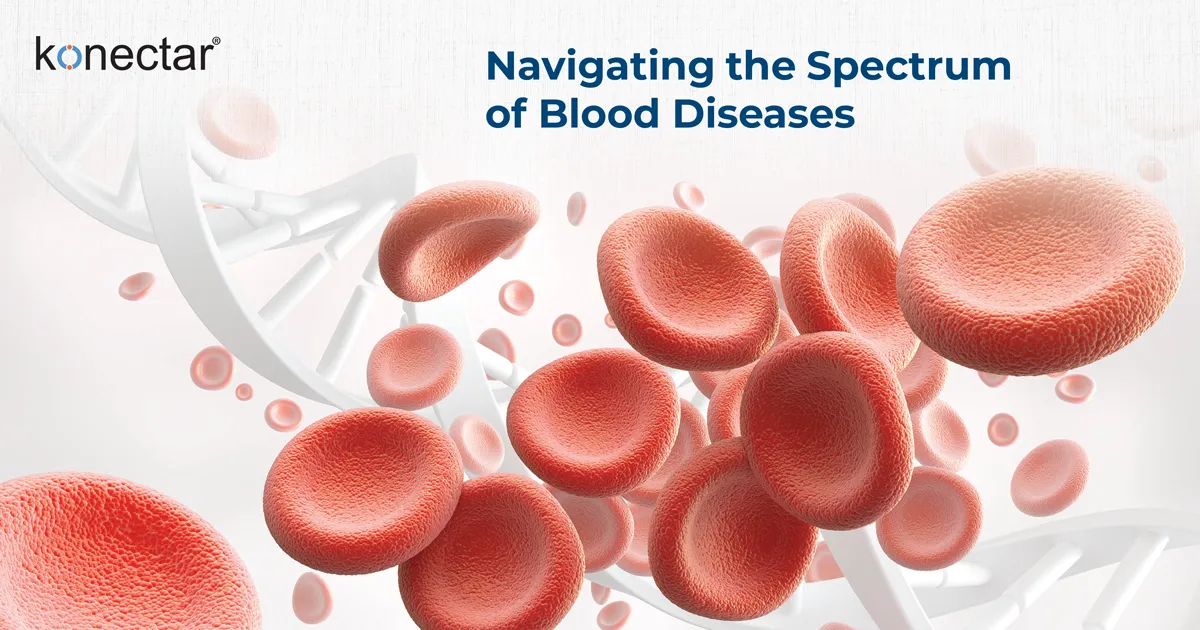29-11-2023
Navigating the Spectrum of Blood Diseases

Blood diseases comprise diverse conditions, each presenting unique challenges and complexities. The spectrum of blood diseases is vast and multifaceted, from disorders affecting red and white blood cells to those impacting platelets, bone marrow, and the immune system. Amidst these challenges, ongoing research and medical advancements offer hope for improved understanding, management, and potential cures for this varied and complex category of illnesses.
In this article, we will comprehensively explore blood diseases, shed light on some blood diseases, and gain insights into the promising advancements that characterize the spectrum of these conditions.
In this article:
Understanding the intricate landscape of Blood Diseases
Blood diseases affect the composition, structure, or function of blood components. According to NIH, most blood diseases can arise due to genetic factors, medications, or lack of specific nutrients. Some blood-related diseases start suddenly and worsen quickly, while others last for months or more, may worsen over time, and might not have a cure.
Described here is a concise classification of blood diseases, divided into two primary categories: Common Blood-Related Diseases and Common Blood-Borne Diseases, and a detailed examination of some specific conditions.
Exploring the Spectrum
-
Anemia
Anemia is a common blood-related disorder characterized by low red blood cells or a deficiency in hemoglobin—the iron-containing protein responsible for transporting oxygen from the lungs to the entire body. The symptoms of anemia can vary but may include tiredness, weakness, shortness of breath, dizziness, and cold hands or feet. Diagnosis involves a thorough medical history, physical examination, and blood tests to measure hemoglobin levels.
The treatment for anemia focuses on addressing the underlying cause. It may involve interventions such as prescribing iron supplements, vitamin supplements, blood transfusions for severe cases or rapid improvement, and implementing lifestyle changes through dietary adjustments.
-
Leukemia
Leukemia, a type of blood cancer, interferes with the production of WBCs in the bone marrow. This overproduction of abnormal white blood cells hinders the body's ability to fight infections. Symptoms may include fatigue, frequent infections, easy bruising or bleeding, swollen lymph nodes, and unexplained weight loss. Diagnosis for this disease involves comprehensive testing, including blood counts and bone marrow examination, and the treatment options include chemotherapy, radiation, targeted therapies, and stem cell transplantation. The management approach depends on factors such as the patient's age, overall health, and the subtype of leukemia.
-
Lymphoma
Lymphoma, a type of blood cancer, affects the lymphatic system, which is crucial for the immune system. It is characterized by the abnormal growth of lymphocytes, a type of white blood cell. The disease presents challenges in diagnosis and treatment due to its various subtypes.
Swollen lymph nodes, fatigue, unexplained weight loss, and night sweats are some common symptoms associated with this disease. Diagnosis involves imaging studies, blood tests, and sometimes a lymph node biopsy. Treatment strategies for lymphoma include chemotherapy, radiation therapy, immunotherapy, and stem cell transplantation.
-
Sickle Cell Disease
Sickle Cell Disease, a genetic disorder is associated with altering the shape of red blood cells. Instead of their usual flexibility, these cells assume a rigid, sickle shape, leading to complications such as pain, anemia, and organ damage. Ongoing research offers hope for advancements in management and potential cures.
Symptoms include pain episodes, anemia, susceptibility to infections, and organ damage. Diagnosis involves blood tests and genetic testing. Management of Sickle Cell Disease focuses on alleviating symptoms, managing pain with medications, and preventing complications through Bone Marrow Transplantation.
-
Deep Vein Thrombosis (DVT)
Deep Vein Thrombosis (DVT) is characterized by the formation of blood clots in deep veins, posing a severe risk if a clot dislodges. Awareness of risk factors and preventive measures is pivotal in addressing this condition.
Symptoms may include leg swelling, pain, and warmth. Diagnosis involves imaging studies such as ultrasound. Treatment includes anticoagulant medications, compression stockings, and lifestyle changes to reduce the risk of clot recurrence. Prompt management is crucial to prevent complications such as pulmonary embolism.
-
HIV/AIDS
HIV (Human Immunodeficiency Virus) infection is caused by HIV that targets the immune system, leading to a weakened immune response. If left untreated, it progresses to Acquired Immunodeficiency Syndrome (AIDS), where the immune system is severely compromised. Early symptoms may include flu-like illness, while later stages can manifest as persistent infections, weight loss, and other complications.
Detection involves blood tests, including the CD4 count, which measures immune system health. Early detection is crucial, and Antiretroviral Therapy (ART) is the primary treatment, suppressing the virus and managing symptoms.
-
Hepatitis B and C
Hepatitis B, caused by HBV (Hepatitis B Virus) and Hepatitis C by HCV (Hepatitis C Virus) affects the liver, potentially leading to chronic liver disease, cirrhosis, or liver cancer. It is transmitted primarily through contact with infected blood or body fluids, as well as unprotected sexual activity. Diagnosis includes blood tests to detect the presence of viral particles and assess liver function. These diseases can be treated with antiviral medications. While vaccination is available for Hepatitis B, no vaccine has been developed yet for Hepatitis C.
-
Syphilis
Syphilis, caused by the Treponema pallidum bacterium, progresses through stages if left untreated. Symptoms vary by stage, from painless sores in the primary stage to organ damage in the tertiary stage. Testing involves blood tests and examination of lesions. Effective treatment with antibiotics, particularly penicillin, is essential, emphasizing the importance of education and regular screenings.
-
Lyme Disease
Lyme disease is known to be caused by the bacterium Borrelia Burgdorferi. It is transmitted through tick bites, primarily from the bite of infected black-legged ticks. The early symptoms of this disease are fever, fatigue, and a characteristic circular rash, while the later stages may involve joint and neurological complications. Diagnosis of Lyme disease can be done through clinical evaluation and blood tests by a Healthcare Professional. Antibiotics such as doxycycline or amoxicillin help in successful treatment of this disease.
-
Septicemia
Septicemia is a severe infection that affects the bloodstream. This condition requires prompt medical attention. Antibiotics and supportive care play a critical role in managing this condition.
1. Common Blood-Related Diseases
2. Common Blood-Borne Diseases
Current Research Initiatives in Blood-related Diseases
-
Gene Therapy
Individuals diagnosed with beta-thalassemia who underwent a singular gene therapy session no longer needed blood transfusions. There were also significant enhancements in their quality of life, as indicated by long-term data. These findings suggest the potential for a curative, one-time therapeutic approach for patients.
For sickle cell disease (SCD), the study delved into the cost-effectiveness of gene therapy. It was observed that gene therapy could serve as an equitable therapeutic strategy for all individuals suffering from SCD.
-
Immunotherapy
A new treatment approach shows promise for individuals with hard-to-treat multiple myeloma. By introducing talquetamab, a Unique Immunotherapy with a different target compared to current treatments, nearly 75% of patients in an early-phase trial experienced a significant reduction in cancer burden within a few months.
These patients had previously undergone at least three unsuccessful treatments, offering hope for a new solution in the challenging landscape of multiple myeloma.
-
Stem Cell Therapy
Cardiff University's research has found the purest blood stem cell population ever identified. This breakthrough has important implications for the future of blood transfusion medicine, cardiovascular disease, and leukemia treatment.
Researchers from Cambridge are working on the clinical trial for Laboratory-grown Red Blood Cells for transfusion, marking a pioneering advancement in medical science. The artificial blood cells were cultivated using stem cells sourced from donors.
If proven safe and efficient, the production of artificial blood cells can potentially revolutionize treatments for individuals with blood disorders like sickle cell disease and rare blood types. This innovation could address the challenge of sourcing enough well-matched donated blood for those with specific disorders, providing a transformative solution.
-
Precision Medicine
SWG-Precision Hematology of EHA (European Hematology Association) is focussing on advancing Precision Medicine in the realm of malignant hematology. The ongoing developmental phase aims to enhance precision by employing new technologies to refine the functional classification of cancer according to its biological aspects. The objective is to elevate precision to a point where personalized therapies become accessible for every patient.
-
Artificial Intelligence (AI) for Improved Diagnosis
Researchers from Helmholtz Munich aim to improve the diagnosis of blood diseases with Artificial Intelligence Technology. They have created the most extensive open-access database, featuring microscopic images of bone marrow cells. The database encompasses over 170,000 individual cell images derived from a diverse set of more than 900 patients afflicted with different blood diseases. They utilize this database as the foundation for an Artificial Intelligence model, demonstrating significant potential for routine diagnostics.
Advocacy and Awareness
According to a survey conducted by ASH to gauge public understanding of Blood Disorders and Hematology, there was a significant lack of awareness among people about blood-related conditions and associated health risks. When participants were asked to name common blood conditions, only a few could identify prevalent issues such as anemia, blood clotting disorders, hemophilia, and deep-vein thrombosis.
These results highlight the need for awareness and easily accessible resources that can help simplify information on blood diseases, symptoms, and treatment options. Advocacy and awareness initiatives are thus essential in the collective effort to address these challenges and improve outcomes for those affected.
FAQs
-
Which specialist treats diseases and disorders of the blood?
Hematologists are specialists who diagnose and treat diseases and disorders of the blood. They address conditions affecting red blood cells, white blood cells, platelets, blood vessels, bone marrow, lymph nodes, and the spleen.
-
What are blood-borne diseases?
Blood-borne diseases are infections caused by pathogens such as viruses, bacteria, or parasites that are transmitted through blood. Some examples include HIV, hepatitis B and C, and certain types of malaria. These diseases can be spread through contaminated blood or blood products, sharing needles, or unprotected sexual contact.
-
What are B-positive blood type diseases?
Blood type B positive refers to a specific blood group characterized by the presence of B antigens and Rh factor (positive) on the surface of red blood cells. The blood type itself does not directly correlate with specific diseases. However, individuals with B-positive blood may be more susceptible to certain conditions or may have varying susceptibilities based on other genetic factors.
-
How many types of blood-borne diseases are there?
There are numerous blood-borne diseases, and they can be caused by various pathogens. Common examples include HIV, hepatitis B and C, syphilis, and malaria. The exact number of blood-borne diseases is extensive, and new pathogens may emerge.
-
What diseases are connected to having rhesus-negative blood?
Having Rh-negative blood does not inherently predispose an individual to specific diseases. However, issues may arise during pregnancy if an Rh-negative woman is carrying an Rh-positive baby. This situation can lead to Rh incompatibility and potentially cause hemolytic disease in the newborn (HDN). In general, the Rh factor plays a crucial role in pregnancy-related complications rather than direct associations with diseases in the broader sense.





